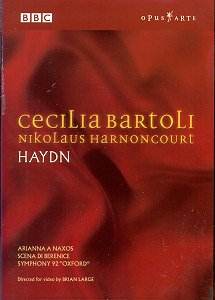Recordings of Haydn’s vocal music are still rare,
although we’re better off now than we were some years ago when
these works were all but never performed or recorded. This recording
by the finest of artists should serve to increase interest in
this aspect of Haydn’s oeuvre.
It used to be required of an opera singer that
he or she raise welts in the far back row under the balcony where
the music critics sat in those gigantic concert halls. Naturally
such power required a large platform from which to launch it.
In the mid 20th century recordings brought to prominence another
kind of voice, one that was supple and dramatic, capable of not
just one or two good notes but of various whole good ranges of
expression. Such voices were often not large, and often disappointing
when heard live in large halls. Now, an additional requirement
has been added — not just how they sound and how they act, but
how do they look with the camera in their face? If Schwarzkopf
was one of the first to pass this test magnificently, Bartoli
is every bit as good. Some other singers — Ewing and Malfitano,
for instance — don’t, whatever their abilities otherwise.
Bartoli sings beautifully demonstrating her agile
high coloratura and rich low range, perhaps overdoing the dramatics
just a little. Our DVD remotes have many buttons, but one that
is not there that is needed is a ‘get back’ button. Both Ariana
and Berenice are angry women, and with Bartoli’s considerable
ability at operatic histrionics — well, it’s wonderful if you’re
sitting in the tenth row. But with her anguished face less than
a meter from you, you keep thinking, ‘God, I’m glad she’s not
mad at ME!’ At times it would have been nice to be able to shrink
the picture to about 5 centimeters wide. But the live audience
was obviously overwhelmed and gave her a resounding, cheering,
ovation. This being unfamiliar music we are probably not ever
going to hear it any better than this.
And as we wander around through the orchestra
while they’re playing by means of the miracle of miniature robot
cameras, odd thoughts run through my mind: ‘The first bassoonist
— I wonder what her hair color is really. I’m glad not
to meet that burly percussionist in a dark alley, he’s having
entirely too much fun pounding on those drums. That’s not really
Charles Bronson playing first cello ...? I don’t notice a wedding
ring; who would I write to to try to get a date with that first
chair player?’ One might say if one’s mind is wandering that much
maybe the performance is not good, but Haydn was very bourgeois
and genial in his aesthetic. Perhaps such thoughts are not out
of place during a Haydn Symphony. But does all this intimacy really
enhance our musical experience? The members of the orchestra are
people working for a living; they make funny faces, drip sweat,
and scratch their noses. Are they entitled to a little more privacy,
a little more dignity? Would they play a little better if I wasn’t
looking them right in the ear?
Of the Symphony #92 this is a fully sculptured
performance attained after many rehearsals. In keeping with recent
classical period scholarship the high brass are more prominent
that one might be used to. Everything is perfect during the first
two movements and I’m thinking this is the best I’ve ever heard
it played; but, on the third movement, the ghost of Beethoven
casts his shadow and all lightness and grace disappear. Not a
phrase goes by that has not been carefully worked out. The music
becomes heavy and awkward, the dramatics forced.
The ‘special feature’ interview video shows some
interesting things. In the Mozart video filmed at the same time
Bartoli seemed to be completely Anglophone, but in this conversation
she speaks English throughout with an Italian accent. Harnoncourt
speaks to her in English, switching instantly to German for the
orchestra, and then Italian when giving everybody their cues in
the cantata text. There is an interesting demonstration of the
three remote control cameras located within the orchestra and
controlled from the control room by joystick.
A video of the Mozart concert arias and Symphony
#38 (released Winter 2003) was taped at the same time, and we
have a generous preview of that.
I could not get my older DVD player out of 4:3
mode, but my brand new player switched easily to 16:9 mode.
Paul Shoemaker
